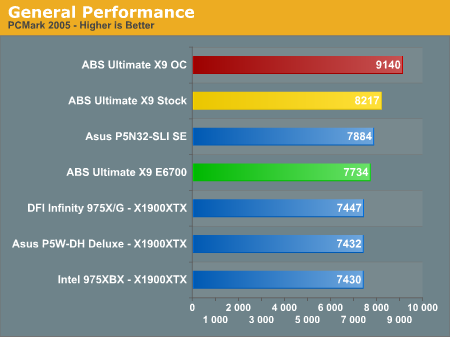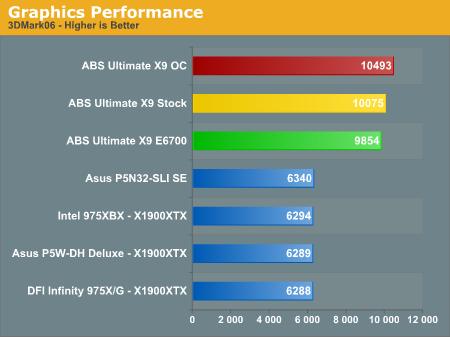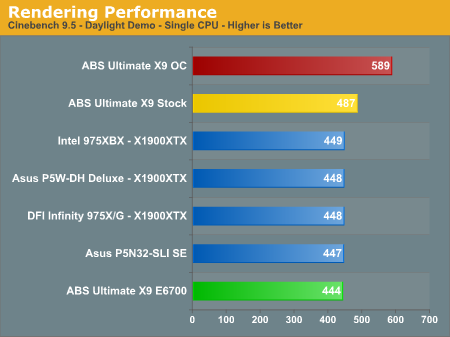ABS Ultimate X9: Core 2 Extreme Hits a Speed Bump
by Jarred Walton on August 18, 2006 1:35 PM EST- Posted in
- Systems
Standard Application Benchmarks
We'll begin with a look at typical application performance. Results from PCMark05, 3DMark06, and Cinebench 9.5 were collected. As mentioned already, the higher clock speed of the ABS system should result in higher performance, particularly in situations where we are CPU limited. Those of you wondering how a 3.5 GHz Core 2 processor performs need look no further.




The results in 3DMark06 aren't particularly meaningful, as none of the other systems were tested with a CrossFire setup. Given that we consider 3DMark to be a synthetic GPU performance test, we're not too concerned with the numbers anyway. One thing that you can see with 3DMark06 is that we are almost completely GPU limited, gaining only 6% more performance with a 32 %CPU clock speed increase. We will see if that same pattern holds true for actual games on the coming pages.
Performance results in PCMark05 are also slightly skewed by the CrossFire graphics configuration, not to mention the use of two Raptor drives in RAID 0. However, we feel these results are more real world, and the simple fact of the matter is that faster hard drives, GPUs, and processors can certainly improve the overall system performance to the point where it is noticeable by the end user. Increases in CPU speed come with a roughly 2-to-1 improvement in PCMark05 scores. The 20% OC is 11% faster than the stock X6800, and the X6800 is 6% faster than the E6700 while being clocked 10% higher.
Closing up with Cinebench 9.5, we have an application that scales almost linearly with CPU clock speed. If your typical usage scenario consists of a lot of video encoding or 3D rendering, faster processors are extremely helpful, and that's what we see here. Cinebench also shows the advantage of multicore systems, improving rendering performance by over 85% when moving from a single core to dual cores. Unfortunately, not all commonly used tasks benefit that much from multiple processor cores, but heavy multitasking will certainly be faster.
We already knew that the Core 2 Extreme was fast, and overclocking it just makes it that much faster. Many commonly used tasks will benefit, particularly CPU-intensive tasks. Games are often considered CPU-intensive in nature, of course, so let's see what happens when we put the X1900 cards to good use.
We'll begin with a look at typical application performance. Results from PCMark05, 3DMark06, and Cinebench 9.5 were collected. As mentioned already, the higher clock speed of the ABS system should result in higher performance, particularly in situations where we are CPU limited. Those of you wondering how a 3.5 GHz Core 2 processor performs need look no further.




Performance results in PCMark05 are also slightly skewed by the CrossFire graphics configuration, not to mention the use of two Raptor drives in RAID 0. However, we feel these results are more real world, and the simple fact of the matter is that faster hard drives, GPUs, and processors can certainly improve the overall system performance to the point where it is noticeable by the end user. Increases in CPU speed come with a roughly 2-to-1 improvement in PCMark05 scores. The 20% OC is 11% faster than the stock X6800, and the X6800 is 6% faster than the E6700 while being clocked 10% higher.
Closing up with Cinebench 9.5, we have an application that scales almost linearly with CPU clock speed. If your typical usage scenario consists of a lot of video encoding or 3D rendering, faster processors are extremely helpful, and that's what we see here. Cinebench also shows the advantage of multicore systems, improving rendering performance by over 85% when moving from a single core to dual cores. Unfortunately, not all commonly used tasks benefit that much from multiple processor cores, but heavy multitasking will certainly be faster.
We already knew that the Core 2 Extreme was fast, and overclocking it just makes it that much faster. Many commonly used tasks will benefit, particularly CPU-intensive tasks. Games are often considered CPU-intensive in nature, of course, so let's see what happens when we put the X1900 cards to good use.










48 Comments
View All Comments
Future1investor - Tuesday, August 11, 2009 - link
I bought this unit in Oct 2006 except instead of the ATI video it has the GF7950GX2-1GB NVIDIA card. I also have a Depot or Onsite 3yr Warranty, which is the issue here.After the liquid cooling pump went out and I started experiencing various problems likely to be related, ABS would not give me onsite service. Instead they wanted me to remove the Liquid Cooling unit, and ship me an air-cooled replacement. After much pain in communications, they then expected me to send it back and then ship me another liquid cooler. But I said with the other problems the whole system needs to be diagnosed properly on the bench.
I shipped the whole computer back at my expense of $87 through UPS. When they received it they again balked saying that they "don't do that" which I interpreted as bench diagnostics. This was confusing because under warranty, the risk of the average user damaging something can be rather high if they are asked to do their own diagnostics and replacements (even given phone assistance). But what of the 3Yr Onsite warranty?
Anyway, long story short; they agreed to bench test and fix what was needed. They told me after a week that they had replaced the liquid cooling unit and the graphic card. I also had a problem with the OS recognizing an additional 4GB Ram same timing, same brand. They said that they'd test for that too but I havn't heard the results. They have closed the RMA and I assume the computer is on route back across the country to me.
Communication has been poor. I don't know if my additional 4GB Ram will be utilized. They changed the Onsite warranty to Depot only. I had to pay for packaging and shipping back to their dock at $87. A few months ago, a phone call to support, to talk about the Ram was met with odd laughter. The person on the phone said it was to be expected for buying that operating system (Windows XP Professional) the only thing available at time of purchase.
This was my second computer purchase from ABS. The first with a 3Yr Onsite Warranty. The tech support is sketchy. They will only call you back from an unidentifiable phone number. They want you to pay for shipping along with any replacement parts, saying that they'll reimburse you once they receive the defective pieces. They want you to do your own repairs. And only if you push the issue to the wall will they attempt normal customer satisfaction (though I paid for it with additional costs to me).
Perhaps ABS' business is not as good as it used to be, and perhaps they are cutting corners and cutting up warranties at the expense of future business.
Considering ABS for a future purchase looks doubtful. Like customer service from Dell. It is a customer nightmare scenario. Though Dell is much much worse! I will be focusing more attention on the warranty service given though Digital Storm. They have one of the absolute highest customer service ratings of any boutique computer retailer. Though I will still monitor the rating in this area for ABS, as perhaps things will improve greatly?
appu - Saturday, August 26, 2006 - link
Just came across this yesterday - http://www.velocitymicro.com/">http://www.velocitymicro.com/How about test-driving one of their systems (although I think we can hazard guesses at the results for the most part)?
These guys also seem like a really nice alternative to building your own box if you don't like generic OEM stuff and don't have the time to put one together yourself. I was definitely impressed with the 15-20 mins I spent on the site looking at various options.
Justin Case - Sunday, August 20, 2006 - link
One month ago all articles around here were saying what a brilliant combination Core + Crossfire was. Now AMD buys ATI, and all of a sudden the conclusion changes to "Crossfire is immature". Interesting...yyrkoon - Sunday, August 20, 2006 - link
"The second item worth nothing is that the NVIDIA SLI solution outperforms all of the X1900 CrossFire configurations, including the 20% overclocked ABS, even when using a slower CPU. Other games might perform better on CrossFire, but there certainly appears to be plenty of room for improvement in the ATI drivers, particularly when it comes to Core 2 optimizations."Saying that ATI needs to iron out thier drivers for core 2 duo is hardly concluding thats 'Crossfire is immature'. Of course, I can pretty much twist something someone says in any dirreciton I want to also. However, I think taken in with the rest of the context, they are trying to say something along the lines that performance wise right_now, Crossfire boards seem to underperform the nVidia varients, but this doesnt mean its going to hold true in the future.
JarredWalton - Sunday, August 20, 2006 - link
On AM2/939, CrossFire often beats out 7900GTX SLI. On Core 2 *right now* it doesn't, at least in the tests I looked at. (I don't have a full SLI 775 Core 2 setup right now, unfortunately.) I've *always* felt CF left a bit to be desired, and I'd say the same thing about .NET and CCC. For whatever reason, some of the issues with CF were magnified on this ABS system. Seriously, THIRTY SECONDS after XP shows the desktop before CCC is finished loading. That's terrible. It's also about 3X as long as a 939 ASUS A8R32-MVP for the same thing, which is why I conclude that CF on C2E has some issues. Of course, the 6.8 drivers may have just addressed a bunch of my concerns - I have to retest that before sending the system back.yyrkoon - Monday, August 21, 2006 - link
I will agree with you that 1 minute OS load times is terrible, hell even my budget Asrock AM2NF4G-SATA2 / 3800+ system boots XP in 18 seconds, and thats from IDE. Not that its cutting edge technology either . . .JarredWalton - Monday, August 21, 2006 - link
It's about 18 seconds to load the OS, but it's 33 seconds of POST codes and 35 seconds of ATI/.NET after XP is basically loaded. With RAID 0 Raptors no less. And people wonder why we at AnandTech often say NVIDIA seems to have more robust solutions....yyrkoon - Monday, August 21, 2006 - link
Well, when I said 18 seconds, its 18 seconds to boot to desktop, and about 1-2 seconds more and its ready to use, however, I just installed the 2.0 framework for microsoft web dev express, and havent rebooted yet. so perhaps it'll take a little longer now. I still dont have 1.1 installed, but on this machine (my gaming rig) I dont plan on installing it, thats what my dev box is for :)JarredWalton - Monday, August 21, 2006 - link
.NET should only affect load times when it is used - i.e. by the ATI CCC drivers. I don't think just installing it really impacts performance. I have it installed on most of my PCs - both 1.1 and 2.0 - and have never noticed any delays on booting, except when using an ATI card.KrazyDawg - Monday, September 4, 2006 - link
I never really noticed that the ATI drivers utilizing .NET was the cause of a longer boot time. In the past, I used omega drivers for my Radeon 9800 Pro but stopped using them when the latest release failed to install properly. I haven't tried other drivers since but a driver review would be interesting and beneficial to many.